Mediterranean race facts for kids
The Mediterranean race was an idea used by some scientists, called anthropologists, mainly from the late 1800s to the mid-1900s. They used this term to describe a group of people they believed shared certain physical features. These people were thought to live mostly around the Mediterranean Sea, in parts of Europe, North Africa, and the Middle East.
Today, scientists do not use the idea of "races" in the same way. Modern science shows that human groups are much more diverse and cannot be neatly divided into these old categories.
Contents
What Was the Mediterranean Race?
In the past, some anthropologists tried to sort people into different "races" or "sub-races" based on how they looked. The Mediterranean race was one of these groups. It was often seen as a part of the larger Caucasian race category.
Where Did This Idea Come From?
The idea of the Mediterranean race became popular in the late 19th and early 20th centuries. Scientists at the time were very interested in classifying people. They believed that physical traits, like skin color, hair color, and body shape, could define different human groups. This was a common way of thinking in that era.
How Was It Described?
People described as belonging to the Mediterranean race were often said to have certain features. These included:
- Medium to short height.
- A slender or medium build.
- Dark hair, often brown or black.
- Dark eyes, usually brown.
- Olive or light brown skin.
- A long or oval face shape.
These traits were thought to be common among people living in countries like Italy, Spain, Portugal, Greece, and parts of France.
Important Thinkers
Several anthropologists wrote about the Mediterranean race.
- Giuseppe Sergi, an Italian scientist, was a key figure. He believed the Mediterranean race was the original group of people in Europe. He wrote a book called The Mediterranean Race in 1901.
- William Z. Ripley, an American economist, also discussed this idea in his 1899 book, The Races of Europe. He described the Mediterranean type as one of the main groups in Europe.
- Madison Grant, another American, included the Mediterranean race in his book The Passing of the Great Race (1916). He mapped where he thought these different "races" lived across Europe.
Why Don't We Use These Terms Today?
The concept of the Mediterranean race, and similar racial classifications, is no longer used in modern science. There are several reasons for this:
- Genetic Diversity: Scientists now understand that human genetic variation is continuous. This means there are no clear boundaries between groups of people.
- Social Constructs: Many "racial" categories were based more on social ideas than on biology. They often led to unfair treatment or discrimination.
- Outdated Science: The methods used by anthropologists in the past were not as advanced as today's genetic studies. Modern genetics shows that human populations are much more mixed and complex.
Today, scientists focus on understanding human diversity through genetics, population studies, and cultural studies. They do not use old racial terms like "Mediterranean race."
Images for kids
-
An Irishman of Mediterranean type, from Augustus Henry Keane's Man, Past and Present (1899).
-
A man from France, used as an example of the Mediterranean race by William Z. Ripley in 1897.
See also
 In Spanish: Raza mediterránea para niños
In Spanish: Raza mediterránea para niños





